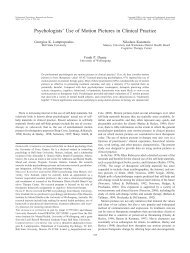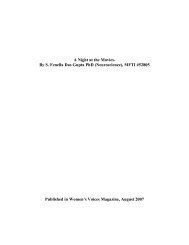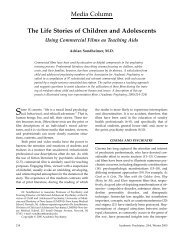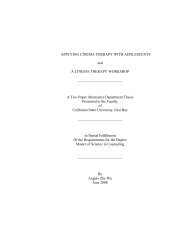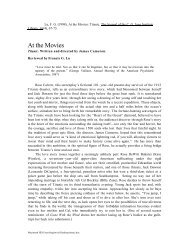Content Analysis of Romantic Comedies IN PRESS ...
Content Analysis of Romantic Comedies IN PRESS ...
Content Analysis of Romantic Comedies IN PRESS ...
You also want an ePaper? Increase the reach of your titles
YUMPU automatically turns print PDFs into web optimized ePapers that Google loves.
<strong>Content</strong> <strong>Analysis</strong> <strong>of</strong> <strong>Romantic</strong> <strong>Comedies</strong> 10There were 73 coded incidents <strong>of</strong> arguing, and 43 incidents <strong>of</strong> relationships ending. It wasquite <strong>of</strong>ten the case that a couple’s relationship ended directly after a heated argument. Withfilms <strong>of</strong>ten linking these two relationship aspects it may be the case that adolescent viewersmay form an association between the two, potentially leading to interpretations <strong>of</strong> argumentsas destructive in relationships.Another category to emerge at this stage <strong>of</strong> coding that may have the potential toinfluence viewer perceptions was “Being Single”. Although this was one <strong>of</strong> the smallercategories, each coded incident (15) was consistently negative. Individuals who were singlewere depicted as either lonely and miserable (such as in While You Were Sleeping where acharacter dejectedly says she has no one to laugh with), frustrated (such as in Hitch, where acharacter expresses her frustration at not having had sex for a year) or made to feel insecure(such as in Picture Perfect where a character attending a wedding on her own is made to feelinadequate). Two films (Keeping The Faith and Picture Perfect) even suggested that beingsingle might interfere with career progression. Such a consistently negative representation <strong>of</strong>being single could therefore have the potential to negatively influence viewers’ feelingstowards being single themselves.Axial CodingOnce all the open coding categories were created, axial coding could be carried out.All 103 open coding categories were examined and from these, 16 axial coding categorieswere created, listed in Table 2.Insert Table 2 hereThe first category, “Affection”, was created from open coding categories that wereviewed to represent couples demonstrating physical affection for one another, as listed inTable 2. Three open coding categories, “Gazing/Smiling”, “Lost in the Moment”, and“Sharing a Private Moment”, although not physical, were also categorised here, as it was



